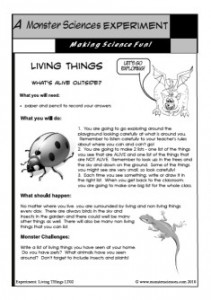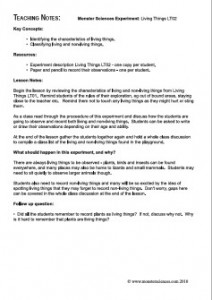Explore your surrounds and find out what is alive – there might be a great deal more than you think!
 |
 |
A Monster Sciences experiment about Living Things: What’s alive outside?
What you will need:
paper and pencil to record your answers
What you will do:
- You are going to go exploring around the playground looking carefully at what is around you. Remember to listen carefully to your teacher’s rules about where you can and can’t go!
- You are going to make 2 lists – one list of the things you see that are ALIVE and one list of the things that are NOT ALIVE. Remember to look up in the trees and the sky and down on the ground. Some of the things you might see are very small, so look carefully!
- Each time you see something, write or draw it in the right list. When you get back to the classroom, you are going to make one big list for the whole class.
What should happen:
No matter where you live, you are surrounded by living and non living things every day. There are always birds in the sky and insects in the garden and there could well be many other things as well. There will also be many non living things that you can list.
Monster Challenges
Write a list of living things you have seen at your home. Do you have pets? What animals have you seen around? Don’t forget to include insects and plants!
Monster Challenges
Write a list of living things you have seen at your home. Do you have pets? What animals have you seen around? Don’t forget to include insects and plants!
Teaching Notes:
Key Concepts:
• Identifying the characteristics of living things.
• Classifying living and non-living things. Resources:
• Experiment description Living Things LT02 – one copy per student.
• Paper and pencil to record their observations – one per student.
Lesson Notes:
Begin the lesson by reviewing the characteristics of living and non-living things from Living Things LT01. Remind students of the rules of their exploration, eg out of bound areas, staying close to the teacher etc. Remind them not to touch any living things as they might hurt or sting them.
As a class read through the proceedure of this experiment and discuss how the students are going to observe and record both living and non-living things. Students can be asked to write or draw their observations depending on their age and ability.
At the end of the lesson gather the students together again and hold a whole class discussion to compile a class list of the living and non-living things found in the playground.
What should happen in this experiment, and why?
There are always living things to be observed – plants, birds and insects can be found everywhere, and many places may also be home to lizards and small mammals. Students may need to sit quietly to observe larger animals though.
Students also need to record non-living things and many will be so excited by the idea of spotting living things that they may forget to record non-living things. Don’t worry, gaps here can be covered in the whole class discussion at the end of the lesson.
Follow up question:
• Did all the students remember to record plants as living things? If not, discuss why not. Why is it hard to remember that plants are living things?



